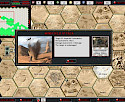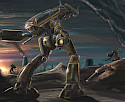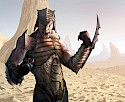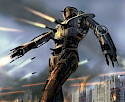Armageddon Empires Review
It's not often a turn-based post-apocalyptic strategy game crosses my desk here at TLO. Probably because I don't have a desk. Armageddon Empires is the brainchild of mad genius Victor J. Davis. Using only a hex-based map, four races, and scores of units, heroes, facilities and abilities, he went and made a strategy game that displays its lineage clearly and rather proudly.
When starting a new game, you have to pick your faction and army size. Everything is represented by cards. Heroes, facilities, tactics, technologies, units: all cards. A collection of cards is arranged into a deck, with which you play the game after it has been randomised. Each card is worth a certain amount of points, and when starting a game you must choose a maximum points limit of either 175, 225 or 275, and the faction you wish to play; the Empire of Man, the Xenopods, the Machine Empire and the League of Free Mutants. Having decided your tile points (5, 10 or 15 - basically how strong your initial HQ fortifications will be), map size (normal, large, huge), how common resources and special discoveries are, and how many opponents you will face, you can kick off. This doesn't take long to sort out. This is a Good Thing. No lengthy tutorial, no fannying about, right into the game.
AE has a board/card game aesthetic, most obviously with the cards and the dice rolls (each die representing a 50/50 chance). Each turn, you roll for initiative, not just to determine who goes first, but who gets the most action points. Action points are absolutely vital because you can do nothing without them. Want to draw a card from your deck? Costs APs. Move a unit? Costs APs. Create a tactic card? Thats right, it costs APs. You're given three dice for the initiative roll, but you can purchase more by spending resources. Resources come in four flavours, and are necessary to play cards, so immediately there's a balancing act where you want to buy more dice, to win the initiative roll, to obtain more APs and move first (and deprive your enemies of APs), and yet have enough resources left to deploy that Corrupter bio-mech.
As you explore the randomly-generated wasteland, you'll come across resources to be collected, discover various bits of abandoned technology, and bump into independent factions who either love you, hate you, or can be bought. The movement itself is slow, you have to click on each adjacent hex to move the unit there, but it suits the game, leaving pathfinding up to the player, making exploration a careful, cautious process. You'll find all sorts of references to other post-apocalyptic fiction, and it's hard not to enjoy finding Vault 13 or recruiting the Band of the Snake ("I heard you were dead!"). A large chunk of gameplay is the exploration and reconnaissance of the map, a lesson which the enemy will soon hammer home. Rough terrain constricts your supply lines and slows movement, and makes it easier for the enemy to hide. You're not omniscient, you only see what your units see, and this is usually precious little. Facilities need to be protected, as they can be taken over or destroyed rather easily. This is one of the precious few strategy games I have ever played where locating the enemies is difficult. Preventing them from finding you, or at the very least denying them access to your facilities, is also very important and even more difficult. Enemy recon units are genuinely sneaky, difficult to keep out of your territory and nearly impossible to keep in sight. Blinding the enemy by destroying their recons and avoiding the loss of your own makes for some genuinely tense warfare, as you battle to keep tabs on your enemies while dodging their efforts to hunt your recons, and stop them finding out about you by locating and killing their recons. A very fine effort at replicating an ISTAR network.
This clash of forces eventually escalates into bigger fights. Aircraft cards are retained, and are only deployed onto the board to attack, taking up valuable space in your hand, but providing valuable support. Ground unit cards are deployed onto the board, and arranged into armies of up to eight units each, meaning you can put together some really murderous forces. However, the bigger an army is, the more APs it needs to move, another nice realistic touch as force size immediately slows mobility. Combat is abstracted to dice rolling, and is quite simple. Units line up in two rows, with the longer-ranged ones on the back row, and take it in turns to twat each other as hard as possible. Their Attack and Defence values come into play, and are represented by dice. You roll, and try to beat your enemy's score, to damage him and then prevent yourself being damaged. That's the simple bit. Complicating the matter, each unit has one or more abilities. Now, do you use your dragon with the 'Shock' ability, and stop one of their units getting an attack, or do you use the dragon with the 'Breakthrough' ability, and take out their artillery next turn? Speaking of artillery, which enemy unit needs Disrupting? Each battle is a rather complex interplay of units, abilities, and tactic cards.
Each race has access to a large array of units, and while most are roughly equivalent to a unit of another race, some of them are unique, and the majority have different abilities. Infantry, armour, artillery, giants, dragons, mecha, bio-mecha, reconnaissance, special forces, aircraft, and each faction has access to several different types of each unit (almost). But once you lose a card, that's it, that unit is gone, and it isn't coming back.
Then there are heroes. Heroes can change several aspects of the game. Heroes are scouts, generals, agents or intellects. They make forces move faster, fight better, increase the size of your hand, increase the range of your supply lines, allow re-rolls, and create tactics and technologies. Tactics and techs are created by passing a dice challenge, tactics cards are then stored in a separate hand, unlike techs which go into your already-stuffed main hand of cards. Techs can be added to your units to make them better (sticking with the card game feel, this adds a little paperclip-button to the card, which you click to see what tech it has, nice touch), and tactics cards can be used in battle to give your forces an edge. Giving some cannon fodder infantry a nuke is always a nice surprise for the enemy.
You hear "Each race plays differently." from strategy games more often than hostile aliens tell you they come in peace, but this time it's actually true. The factions are appreciably different. The Cthulhurific Xenopods have access to Psi powers that work wonder on biological enemies and enjoy randomly spawning units from dead bodies, the Humans are the all-rounders, the Mutants have no air units but love guerrilla warfare, and the Machines don't need the 'human' resource and have fairly heavyweight forces.
The pace of the game is quite quick, individual turns don't take long due to the AP limitation, even if you come first and get the most APs every turn (you won't), you still won't be able to do everything you want to do unless it's early on in a battle, while you're still gearing up. As you get established with some decent forces, prioritisation becomes more pressing, as you fend off multiple enemy scouts and yet still try to get that unwieldy army of super-powered killers into action. Smaller games can be over in minutes, especially if you're sneaky and send in some commandos to capture the enemy HQ on turn four. The bigger games last about three or four hours, and the speed with which you can complete a turn means you can easily play in short bursts or settle down for a while to play a few games and refine your deck.
Ah, deck creation. The creator isn't too difficult to use, as the cards are separated into their categories (infantry, special ops, facilities, and so on), it just takes bloody ages to put a deck together. Good thing there's four starter decks to get you going.
The graphics and sound aren't brilliant, it's true. The post-apocalyptic wasteland is unremittingly beige, but then it is a wasteland, and not Normandy, 1944 (a strategy game not set in WWII? Another plus point!). The screen gets a bit crowded, there's no fancy graphics, you can't even zoom in or out (though there is a minimap). The only visual aspect you could boast about, and it is worth a bit of boasting, is the card art. Put together by artists Matt Bradbury, Katie Davis, Mike Grills, Jon Hodgson, Ric Lim Boom Keat, Aaron Porter and Zdenek Sasek, it's quite obviously not the stuff usually quickly knocked out for games. This stuff is proper Art, and while I'm not playing the "Are computer games art?" card here, they can definitely contain art. The only bad thing you can say about the card art is that it's not bigger, because it's gorgeous. Even the most minor facility has it, and it adds colour and character to what is otherwise just text and a rectangle on the board. Sonically, effects are minimal and the one looping tune is listenable and bearable even for extended periods if turned down a bit.
AE doesn't have any campaign or multiplayer modes. It is what any other strategy title would call a 'skirmish' mode, and yet still has longevity, which speaks for its quality. The game is ultimately about scarcity, of APs, of units, of resources, of space. The scramble and constant battle for all of these things, combined with game mechanics that let you stack the odds in your favour yet always allow chance a say, make the game compelling. I can see the board/card game feel turning some people off, and dark mutterings of "Might as well be a board game." and technically, I suppose AE could be a board game, albeit one that was nigh-unworkable, being 99% accounting and 1% actually playing. It's best left to computers. AE is a bare-bones game which does none of the work for you, and it was made by someone who has some knowledge of military goings-on, loves games, and has paid attention to detail. And we can always play more games like that.












